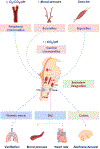Autonomic and respiratory consequences of altered chemoreflex function: clinical and therapeutic implications in cardiovascular diseases
- PMID: 36907827
- PMCID: PMC10989193
- DOI: 10.1002/ejhf.2819
Autonomic and respiratory consequences of altered chemoreflex function: clinical and therapeutic implications in cardiovascular diseases
Abstract
The importance of chemoreflex function for cardiovascular health is increasingly recognized in clinical practice. The physiological function of the chemoreflex is to constantly adjust ventilation and circulatory control to match respiratory gases to metabolism. This is achieved in a highly integrated fashion with the baroreflex and the ergoreflex. The functionality of chemoreceptors is altered in cardiovascular diseases, causing unstable ventilation and apnoeas and promoting sympathovagal imbalance, and it is associated with arrhythmias and fatal cardiorespiratory events. In the last few years, opportunities to desensitize hyperactive chemoreceptors have emerged as potential options for treatment of hypertension and heart failure. This review summarizes up to date evidence of chemoreflex physiology/pathophysiology, highlighting the clinical significance of chemoreflex dysfunction, and lists the latest proof of concept studies based on modulation of the chemoreflex as a novel target in cardiovascular diseases.
Keywords: Arrhythmias; Baroreflex; Chemoreflex; Ergoreflex; Heart failure; Hypertension; Sleep apnoea.
© 2023 European Society of Cardiology.
Conflict of interest statement
Conflict of interests
The authors have no conflict of interest to declare.
Figures




References
-
- Javaheri S Determinants of Carbon Dioxide Tension. In: Gennari FJ, Adrogue HJ, Gall JH, Madias NE, eds. Acid-Base Disorders and Their Treatment 1st ed. Boca Raton: Taylor and Francis; 2006. p. 47–77.
Publication types
MeSH terms
Grants and funding
LinkOut - more resources
Full Text Sources
Medical

